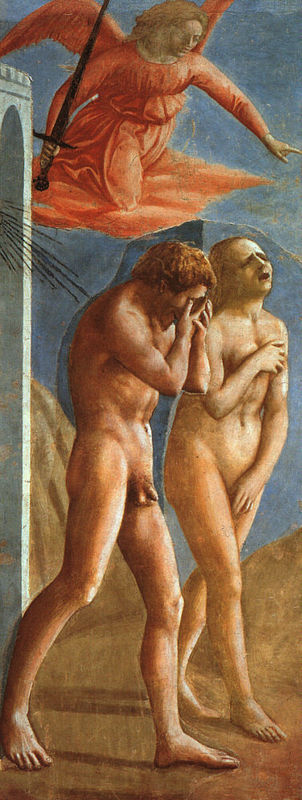The Shame of Adam and Eve and the Condemnation of Humanity.
Adam and Eve gave in to temptation by eating from the tree in the middle of the Garden of Eden. The Book of Genesis tells the story of Adam and Eve’s banishment from the Garden of Eden and highlights what happens to those who forget and abandon their relationship with God. However, the Book of Genesis does not shed light on the pain, regret, and shame Adam and Eve felt after they gave in to desire.

Shame shown through the Expulsion from the Garden of Eden.
Masaccio’s Expulsion from the Garden of Eden illustrates not only the pain of Adam and Eve but depicts the raw emotion of what it means to be human. Masaccio’s use of nakedness develops the theme of shame for us– a theme not represented in the Book of Genesis.
God learns of Adam and Eve’s betrayal when Adam and Eve try to hide their nakedness from him– nakedness symbolizes their vulnerability and their newfound knowledge. In the Book of Genesis, as God banishes Adam and Eve, he simultaneously clothes them with skin coats. Because God is a merciful God, he protects Adam and Eve even after they have betrayed his trust. Masaccio, however, chose not to show this merciful side of God. Instead, he wanted to solely focus on the vulnerability of Adam and Eve. Adam covers his face, hunched over in shame as he disobeyed his ultimate creator. The striking lines reaching towards Adam’s back can be read as God’s condemning words of judgment: Masaccio only focuses on God’s punishment rather than his mercy. Contrary to Adam, Eve attempts to hide her shame by covering her nakedness. She cannot hide, however, her horrifying expression. We can almost hear her cries through her distorted features. The dark and twisted nature makes it uncomfortable to look at Adam and Eve, as we feel the shame in their emotions.
Why did Masaccio rebel against the Book of Genesis?


Masaccio, instead of painting Adam and Eve as religious figures, paints the pair as suffering human beings. Masaccio’s radical departure from the Book of Genesis emphasizes the pain and vulnerability we would feel if we were to ever disobey a merciless God. However, we do not see this vulnerability in Masolino da Panicale’s religious account of Adam and Eve (Temptation of Adam and Eve). Masolino painted a human head on the snake, clarifying that this is before Adam and Eve gave in to their desires; Masolino wanted to maintain the pureness of Adam and Eve. This heavenly appearance of the pair makes it seem as though they are impervious to danger and all vulnerabilities. However, we quickly lose this innocence as we look at the drastic undignified version of Adam and Eve in Masaccio’s account sitting directly across in the Chapel. Masaccio illustrates Adam and Eve in severe agony, darkness, and shame shown through their nakedness and horrifying expressions. He rebels against the pure holy account of Masolino and the Book of Genesis to showcase those human emotions. Masolino’s painting illustrates a story, whereas Masaccio’s painting evokes our empathy for Adam and Eve’s suffering.

Masaccio’s crucial use of nudity.
Masaccio’s use of nudity was an essential, yet scandalizing, choice in his portrayal of the expulsion of Adam and Eve. Cosimo III de Medici demanded to cover up the pair with fig leaves– an inaccurate account of Genesis because God clothed them with skin coats. Masaccio not only went against the word of Genesis but went against social decorum. Masaccio mercilessly exposed Adam and Eve’s vulnerability, similar to how he illustrated God’s merciless rejection of Adam and Eve. Adam and Eve’s nudity made viewers disgusted and uncomfortable, thus forcing them to feel the same vulnerability Adam and Eve felt as well. Masaccio demonstrated vulnerability and was shamed for his own scandalizing choice, further emphasizing the humiliation he wanted to depict in his painting.
Our relationship with Adam and Eve.
Masaccio’s portrayal of the condemnation of Adam and Eve transforms the pair from religious figures into human beings we can relate to: they demonstrate very human emotions such as sorrow, fear, and shame. Rather than painting a new story to invoke the theme of shame, Masaccio specifically chose to retell one of the most infamous stories in Genesis. By taking a different approach in portraying the fall of Adam and Eve, Masaccio provokes us to relate our own vulnerabilities to two of the most world- renowned religious figures. Understanding that God’s first two subjects also faced prevalent raw emotions allows us to apply the word of God in our own perspective.
Isabelle Malone is a freshmen at Colgate University. She is from Chappaqua, New York, and is planning on majoring in Neuroscience or Psychology.